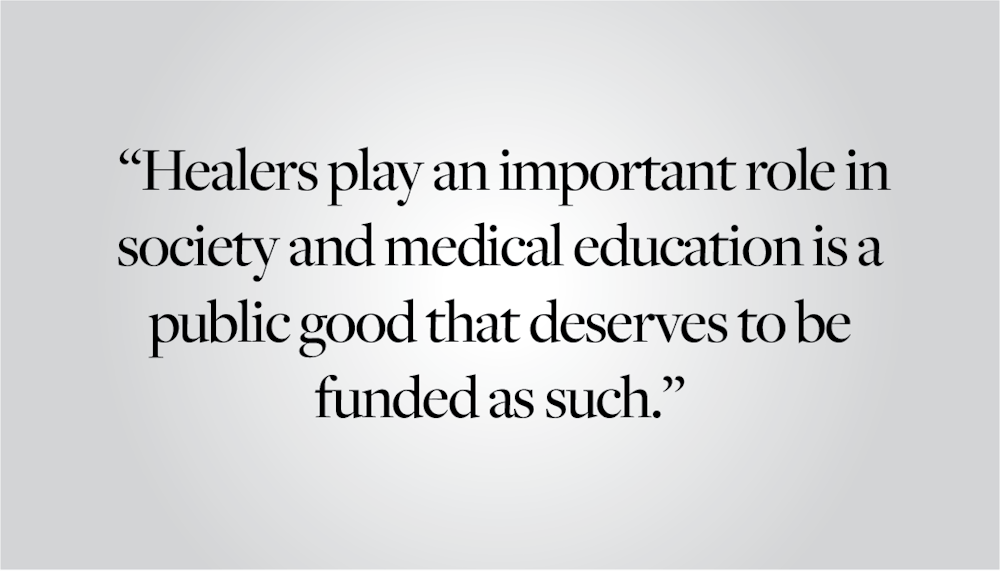According to the Association of American Medical Colleges, the average physician today graduates with about $200K worth of medical student loan debt. While physicians, who are amongst society’s highest earners, can undoubtedly bear these costs, we ought to consider rethinking how we finance medical education in order to diversify our medical workforce and improve patient outcomes. Brown must do more to provide adequate financial support for medical students in order to continue to attract the next generation of physician leaders.
It’s no secret that the United States currently faces a shortage of doctors across specialties. This deficit is felt most acutely in primary care specialties, which provide some of the most cost-effective care in the American system. However, given lower starting salaries and equivalent amounts of educational debt, the current system disincentivizes and places a disproportionate financial burden on those who pursue this noble field. Furthermore, while diverse practitioners provide better outcomes for patients, more than half of medical students hail from families with income levels in the top 20% and the racial demographics of medical students do not reflect that of the nation more broadly. Shifting the cost burden from individual physicians to society at large will provide access for students from historically underrepresented groups and create pathways to pursue, lower-paying careers in primary care or research unburdened by medical debt. This increase in diversity and change in specialty choice will directly augment patient care. Additionally, medical debt is an equity issue as Black and brown students are disproportionately burdened by it. Furthermore, reducing loan expectations will also likely help address burnout and substance abuse among medical students.
Medical schools, such as Brown’s Warren Alpert Medical School, have a tremendous impact on the communities in which they reside. In the state of Rhode Island, about 8% of physicians are Alpert graduates and 59% of in-state practitioners are affiliated with the school. Additionally, the University’s Division of Biology and Medicine draws in more than $55 million yearly in external research funding, some of which is put toward advancing groundbreaking cures for diseases such as Alzheimer’s, ALS, and cancer. By keeping the cost of medical school high, Warren Alpert and comparable institutions fail to account for the benefits that come with attracting a more diverse and potentially better-qualified student body, who would ultimately bring advanced care, innovative research and jobs to the state. Therefore, the Rhode Island legislature, our affiliated healthcare systems and other stakeholders ought to internalize medical school costs by offering more loan forgiveness and funding for the state’s medical institutions.
While state and federal funding are critical to ensure the continued supply of new physicians, the University on its own can play a role in lessening the financial burden. While Warren Alpert does currently provide financial aid to medical students, it does not meet 100% of demonstrated need and the school expects students to take out a base loan before providing aid. This results in an average debt burden of $170K which is much greater than Columbia’s $98K, Cornell’s $105K, Yale’s $106K, Harvard’s $108K and Penn’s $128K. To remain competitive, Brown ought to fundraise aggressively to improve the state of financial aid at Alpert. We should follow the lead of Columbia, Cornell and Yale in removing base loan expectations or that of Penn in providing full-tuition merit scholarships to a significant number of its students. In order for Alpert to live up to its promise as a top medical school, we need to reign in costs for students in order to attract the best and brightest providers to Rhode Island.
Medical school, much like undergraduate education, should not be open only to those who can afford it. Students in the Program in Liberal Medical Education, Brown’s eight-year baccalaureate/MD program come to Brown on the promise of generous financial aid during their undergraduate years and are left shocked when faced with the high loan burdens at Alpert. Building on the success of its BrownTogether fundraising campaign and realizing the vision to expand our research footprint, Brown has a unique opportunity to make its medical education more accessible and improve the well-being of its students and the communities they will serve. Freeing doctors from the burden of debt, creating opportunities for diverse practitioners and giving them the ability to enter fields like primary care, will improve the quality of care offered within the state. But this effort will require coordination and collaborative investment from government, community partners and medical schools alike. Healers play an important role in society, and medical education is a public good that deserves to be funded as such.
Tas Rahman ’26 can be reached at tasawwar_rahman@brown.edu. Please send responses to this opinion to letters@browndailyherald.com and other op-eds to opinions@browndailyherald.com.

Tas Rahman is an opinions editor at the Brown Daily Herald writing about issues in higher education. When he's not coding or studying biochemistry, you can find him hiking and enjoying the great outdoors.





